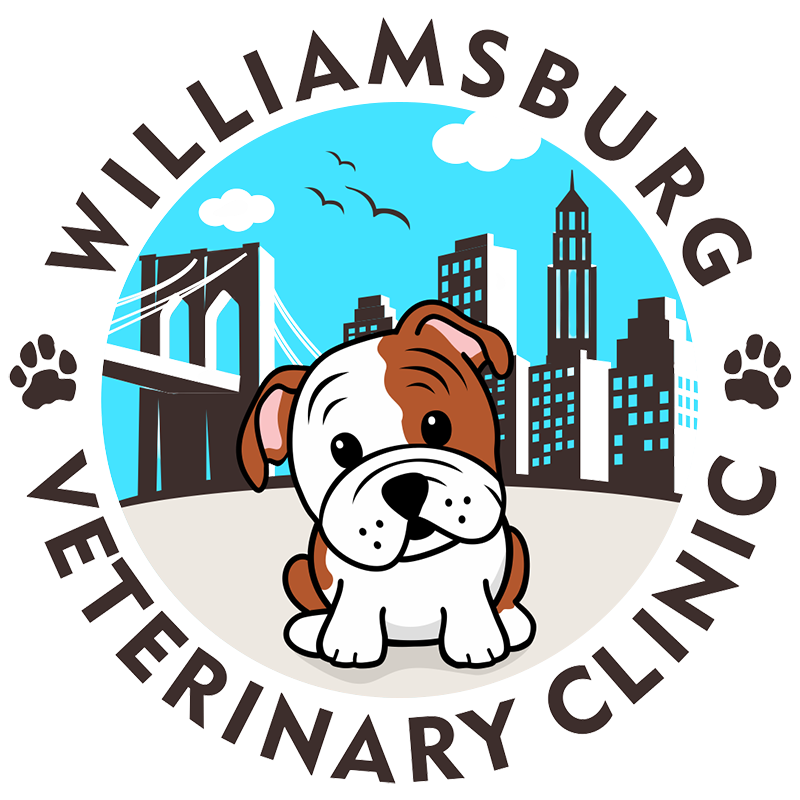Client Education
CanineVaccinations
Please review our pet vaccinations in accordance with the 2022 AAHA Canine Vaccination Guidelines.
Vaccination Information
Click the toggles below to explore details about the vaccines we provide.
Rabies
Virus (family Lyssaviridae). Zoonotic disease (can be passed to humans). Affects nerve cells, causing neurological signs and death. Transmitted by bite wounds through the saliva of infected animals. All mammals are susceptible to rabies (including humans). The most commonly infected mammals in NYC are raccoons, bats, and skunks. The rabies vaccine is required by law in NYC for all cats and dogs. Core vaccine.
Schedule: First vaccine is given between 12-16 weeks of age and every 1-3 years thereafter.
Canine Distemper-Adenovirus-Parainfluenza-Parvovirus Combination Vaccine (DHPP or DA2PP)
Also referred to simply as the “distemper vaccine.” This combination vaccine protects from some of the most serious canine viruses. Core vaccine.
Schedule: First vaccine is given between 6-8 weeks, then every 2-4 weeks until 16 weeks of age, and then every 1-3 years thereafter.
The components of this vaccine include:
- Distemper: Virus (family Paramyxoviridae). Same family that causes measles, mumps and bronchiolitis in humans. Causes gastrointestinal, respiratory, and neurological signs. It is highly contagious and infects a variety of mammalian species. It is passed through infected body fluids, contaminated water, aerosolized droplets. Puppies are most susceptible.
- Hepatits or Adenovirus-1: Virus (family Adenovirus). Causes inflammation in the liver (hepatitis).
- Adenovirus-2: Causes respiratory disease (canine infectious tracheobronchitis aka kennel cough).
- Parainfluenza: Virus (family Parainfluenza). Causes mild respiratory disease in dogs (canine infectious tracheobronchitis aka kennel cough).
- Parvovirus: Virus (family Parvovirus). Highly contagious viral infection that affects the digestive and immune systems (i.e. bone marrow) of dogs. Causes severe and debilitating diarrhea and vomiting, and in some cases, death. Puppies are most susceptible.
Bordetella
Bacteria (Bordetella bronchiseptica). Causes upper respiratory signs including a hacking cough +/- ocular and nasal discharge. The vaccine does not eliminate the possibility of a dog becoming infected, but it may help to decrease the severity of signs. Non-core vaccine but should be given to all brachycephalic dogs who are at increased risk for complications from upper respiratory infections.
Schedule: Can be started as early as 3-4 weeks but most generally started at 8 weeks. Intra-nasal and intra-oral vaccines do not require booster; SQ vaccines requires booster 2-4 weeks after first vaccine, and then yearly thereafter. Non-core but required for hospital stays (i.e., neutering).
Leptospirosis
Bacteria (spirochete). Zoonotic disease. Passed through the urine of infected wildlife, such as rats, raccoons, skunks. Dogs become infected by drinking out of contaminated puddles or stagnate water. Infections can be deadly, causing liver and kidney failure. Core vaccine.
Schedule: Can be started at 6-8 weeks; requires booster 2-4 weeks after first, then yearly thereafter.
Canine Influenza Virus (CIV)
Virus (family Orthomyxoviridae). Cause ‘the flu” in dogs with upper respiratory symptoms and coughing and may progress to pneumonia. Dogs at highest risk are brachycephalic breeds and those that closely associate with other dogs, at boarding or grooming facilities, or that make regular visits to the dog park. Dogs at risk for kennel cough are also at risk for CIV. Non-core vaccine but should be given to all brachycephalic dogs who are at increased risk for complications from upper respiratory infections.
Schedule: Can be started at 6-8 weeks of age; requires 1 booster 2-4 weeks after first, and then yearly thereafter.
Lyme
Bacteria (Borrelia burgdorforia). Transmitted through the saliva of an infected tick. It generally takes anywhere between 24 to 48 hours of tick attachment before transmission of bacteria from tick saliva into an animal’s blood stream. Can cause lethargy, anorexia, shifting-leg lameness, and fever, though most infected dogs are non-symptomatic. Non-core; recommended for dogs that go regularly to tick-endemic areas.
Schedule: Can be started 8-9 weeks of age; requires 1 booster 2-4 weeks after first, then yearly thereafter.
Our veterinarians will discuss the best vaccine schedule for your dog based on their breed and lifestyle.
